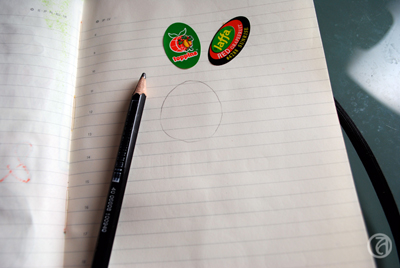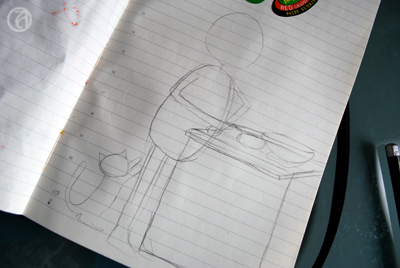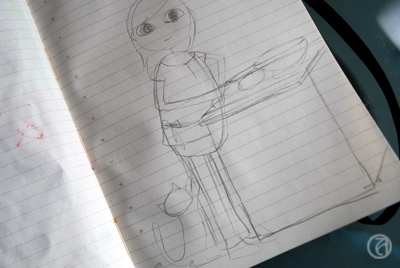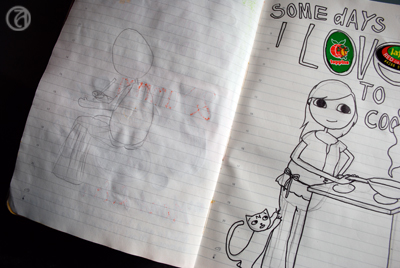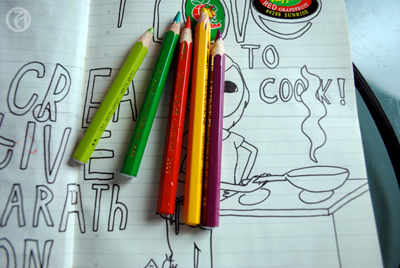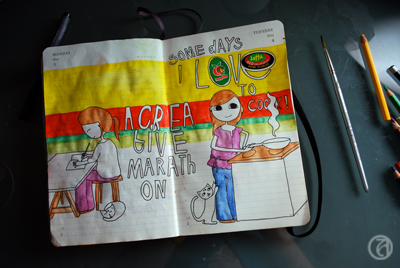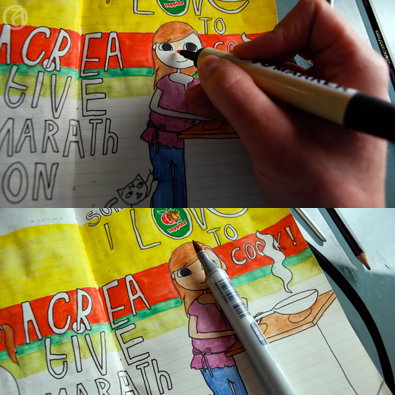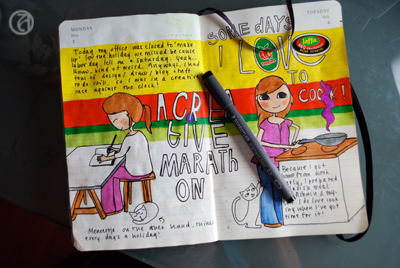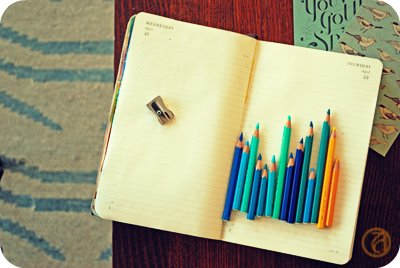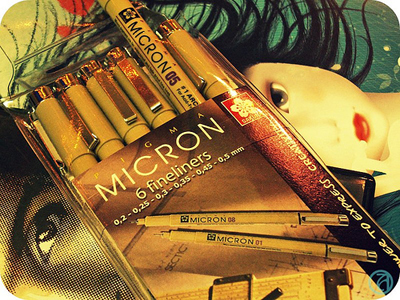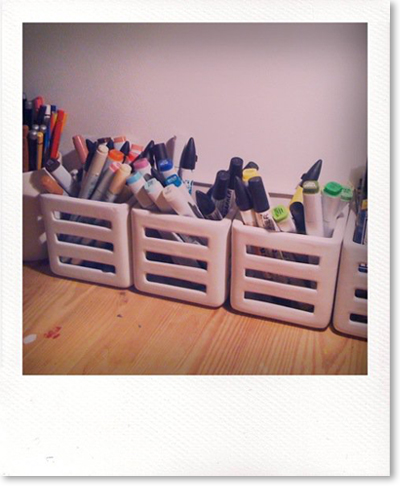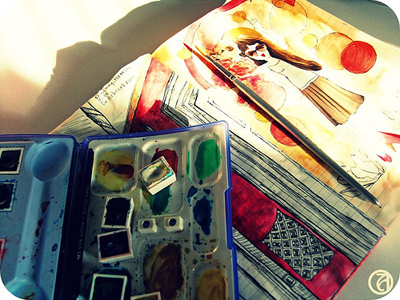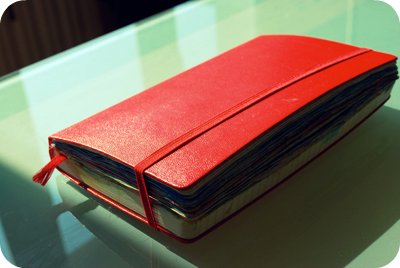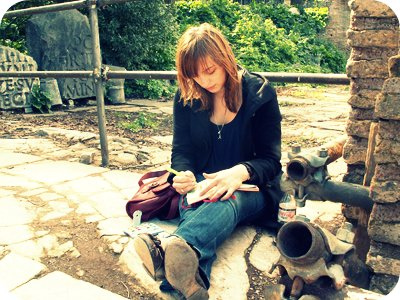As I mentioned before, Christmas comes early in Holland, and it's actually not Christmas, but Sinterklaas and despite the crazy and probably true things you've about it, it's actually an awesome tradition.
© Anna Denise Floor
This year, we celebrated Sinterklaas a day late, as Mr. Floor was traveling for work, but actually that was fine as I think holidays should always just be on Friday evening, so the elderly amongst us (including myself these days) have at least two days to recover.
Overwhelmed by all the awesome shoe action, I felt like I had to do better than just buy a book and be done with it, so I bought two books, a wintery sweater, and made a date night out of it. Snacks included. I drew a 'map' with numbers on the floor with washi tape, indicating the order of the gifts. It was awesome, and yes I am aware that I'm bragging so I'll stop now. I think the man enjoyed it.
© Anna Denise Floor
Sinterklaas is here! And what a perfect night it is. Dark and stormy. I can just picture all kids all around the country are hopped up on adrenaline and sugar, tearing open their hard earned gifts as we speak.
Even though Sinterklaas was kind enough to move our share in the festivities to the weekend (he's such a flexible old man), my shoes have been doing some serious overtime these past few weeks. And by that, I mean, my mysterious Sinterklaas has been filling my shoes with the most amazing gifts, as illustrated above.
Hope you're all enjoying your Sinterklaas, Dutchies! I know I sure had enough speculaas for the year, already. Bweurgh.
I ate, I ate some more, made another attempt at skiing, and am completely enthralled by the gorgeous book 'A Map of the World', Sinterklaas gave me.
© Anna Denise Floor
This week, I was in London for work and I worked out. Oh, and I stole my husbands idea for a drawing. Happy weekend!
© Anna Denise Floor
© Anna Denise Floor
So quiet (but good quiet!) that I've got my drawing finished for the weekend already. So no one do anything crazy this evening, because it will NOT be recorded, y'all. I repeat: it will NOT be recorded. 0_o
PS: The mushroom book is really quite awesome. I'll post about it soon, as I tried taking pictures of it today, but the crappy lighting shat all over that marvelous idea.
Journal page © Anna Denise Floor
Learning new things really is one of my favorite things in life, but it also means my list of things I suck at is longer than most people's.
Soccer? Disaster. Knitting? Ehm. Humbling? Tennis? A chapter in my life we will not speak of ever again. Walking? An ongoing battle.
But mostly - learning new things is just great fun and good practice of cultivating your 'beginners mind'. Some things I learned this week: I relearned that I actually love skiing and am pretty unafraid (we even did some little jumps!), even though I'm an absolute beginner of course . I also learned that my husband is a great teacher when I allow him to teach me new things (heh. Not that I'm usually stubborn or anything...) and that ski pants don't have to make your butt look unattractive (I know right, this was totally holding me back as well). I found out (again), that I'm apparently quite attached to my old boring hairdo. Ah. Such important life lessons here. Next up: enlightenment. BAM!
Oh oh!
Impression of 'me' wearing 'The Knit Kid', for Oh Marie! © Anna Denise Floor
Oh, oh, oh hold on! Before we go there - I wrote/drew a post for the Oh Marie blog, where I discuss and illustrate my Etsy crushes. It'll be a monthly installment, and first up is my ongoing love for The Knit Kid. Read the post here!
Also, if you've never heard of Oh Marie!, go check it out. It's an amazing (free!) online magazine with tons of gorgeous photography, great articles, and DIY magic. Their last issue (#5) was just published and it's once again stunning. Check it out here.
I used to do a photo every year of the sh... I carry around in my bag, but neh. You get a drawing instead.
© Anna Denise Floor
This week, I've been carrying around a screenprinting kit as well, put together by Femke from Windstilte. I took a screenprinting course over at Urlaub this weekend, and it was great big fun (see a small snapshot of my castle scarf here on Instagram).
Why is it still in my bag, you ask? Well, folks. Because I'm a pig. That's why.
© Anna Denise Floor
Click on the image for a larger view.
Don't you just luuurrrve the internet? I sure do, and not just because I get to connect with far-away friends and strangers, work and collaborate internationally, and have 24-hour access to information and inspiration (someone say kittehs?). No, actually it's because I get to update everyone on what I eat all day. Heck yes, Instagram, and heck yes, drawing my food. Because I know you care. Deeply.
© Anna Denise Floor
Am a bit behind on posting my journal pages as you can see. These past two weeks have been absolutely nuts. I travelled to London and Dublin for work (yes, my life is actually that awesome, hate me), threw a big wedding celebration with the Fantastic Mr. Floor, somehow messed up my big toe, making it ever harder to walk normally, and generally spent a lot of time feeling Very Responsible for Everything (which is a great way to spend your time. Squiggly mouth smiley face).
Anyhow - here's a drawing. Tadah!
Now go away and ignore the fact that it's almost freaking November.
Journal page for the weekend of October 4-6, 2013 © Anna Denise Floor
Look at me posting this within the week. To be honest, I had this finished on Monday, but I had some other posts lined up and I wanted to spread them out a bit all professional-like. So here it is. If you're in Amsterdam: go see that Pixar exhibition before it ends. It's awesome. I may go back for more myself.
© Anna Denise Floor
It's been raining this week and Monday and Tuesday I've been mostly cooped up inside, enjoying the comforts of working from home, drinking coffee from our new machine and starving to death as obviously I wasn't going nowhere near that supermarket in this kind of weather. Ok, that's not true. Ok, it is. All I'm saying that cookies were consumed.
© Anna Denise Floor
In the final part of this tutorial, I would like to talk to you about drawing and about how to put this together with all the things I’ve talked about in the previous two parts (topic, layout, colors, and materials).
I know for most of you the drawing part is the hard part. I think this is why most art journal courses you can take online focus mostly on collage, mixed media, and scrapbooking techniques (The girls over at Red Velvet Art have a pretty awesome art journal course going on right now). Now, I like that, don’t get me wrong. Like any crafty girl I love beautifully patterned papers and ribbons, but there’s something about drawing, actually illustrating my day that really works for me. I think it’s because I am a highly visual person, it feels more natural for me to draw it myself.
Now, before I actually start I would like you to consider two things:
1. I never went to art school and never took any classes, so I don’t have an advantage over you besides the fact that I’ve been drawing every day for the past four years. I think drawing is a skill you can learn by being patient with yourself and practicing.
2. Ask yourself: Who are you doing this for? Who are you keeping an illustrated journal for? I think in the end, you should be doing this for YOU. Sure, it’s loads of fun to share a pretty page you’ve made online and get nice feedback, but in the end, keeping a journal is a personal way of documenting your experiences. It will bring back memories every time you look at the page you’ve made - and for me, that’s what journaling is about.
So please give yourself permission to make mistakes and accept that things will not be perfect. You’ve probably come here because you like my drawings, but I can tell you on nearly every page of my journal I feel there’s something I could have drawn better and I'll give you an example in this installment!). We’re our own harshest critics and I think that’s just going to be what it is. Doesn’t mean it stops me from enjoying drawing or putting together my pages, or looking at those pages when they’re done. After all, it’s about documenting your experiences, not about being a professional illustrator or artist or whatever. Just have fun!
But yes, drawing is more fun with some basic steps, so here’s what I’ve learned!
Drawing and putting it all together
The topic... This particular day, I cooked my boyfriend a lovely dinner that I very much enjoyed making. Since this hadn't happened in a while (been too tired), I decided to draw about this. After I’ve determined the topic of my page I will think about what it was about that experience that stood out to me. 99% of the time it involves ME (since, hey, this IS my journal) and I’ll start with a sketch of a figure. I'll work in pencil first.
I sketch out the basic shape of the head first. I use some kind of egg-shaped head, but you can make it round, oval, whatever works. I then sketch out a bean-shaped form for the body. Of course this is all very anatomically incorrect, but it sure looks cute. The legs and arms are just little tubes sticking out. Depending on the subject I try to come up with a semi-realistic pose. Sometimes I check in the mirror what it looks like when I keep my hand behind my head or look at pictures. Where does the elbow bend? The wrist?
As you can see, I’m not sketching out the details yet, because I still want to be able to change things around if I feel it doesn’t work and too much detail just makes it more complicated. Getting the basic shapes right is my main priority here.
I then go on to fill in other elements in the drawing. Not too many, since I don’t like my pages to be too cluttered. What I’ve learned is that with just a few elements, you can already make a nice looking page that gets the message across. For example, in this case I could have chosen to draw the entire kitchen, but instead I chose to draw just the stove I made the food on.
When I’m happy with my little ‘stick figure’ and the elements around the figure, I start drawing in the details. I'll start with the eyes, in this case just simple oval shapes. I try to get them to be the same in size and shape and on the same 'line'. I think this is the key to making your figure look good. Start by getting the outline right. If the eyes are not on the same level, or different in shape, just erase the one you don’t like and try again. When you’re happy with the position and the shape, you can draw in the pupil. I usually put them in the middle, because I like my figures to look at me, plus, it’s also pretty easy to draw when you’re a beginner. Even easier to draw are the closed eyes. Upward half moons usually give a happy impression, downward half moons usually give a peaceful impression (or sleepy, depending on the mouth). For the hair, be sure to place the top of the hair a bit above the skull you’ve drawn, unless you want your figure to look like she’s been standing out in the rain a tad too long.
When I'm happy with what I've drawn, I will trace the final outlines with a fineliner. Now, I'm not an expert on perspective, but I am always sure to remember to trace the lines of the elements that are in front of the other elements first. You don't even want to know how often I made that silly mistake, just because I was focusing on getting every single shape perfect.
Next step is adding the text. I now do this without sketching out the letters first, but the first couple of years I always sketched them out first. And I probably still should, as I often find I misspell my titles just because I'm too focused on my lines instead of on the actual text. As you might have noticed, there were two grapefruit stickers on the page before I started drawing. I often just paste in little things like that on random pages so they'll surprise me when I get to that page and add a bit of spontaneity to the page. In this case, I used the stickers as part of the text.
Usually I'll draw chronologically (starting on the left page first), but I was a little behind on my 'homework' and I worked on the left page after finishing the sketch on the right page.I decided at this point I would try to use the horizontal layout here, mainly because the topics are very different (the left page is about working on my art journal!).
The right page of this spread is very vertically oriented, and I attempted to compensate for this by adding the title of the page on the left more to the center of the spread. There's still not a lot of continuity between the two pages, though, so this will have to be achieve through color.
I chose the colors for this spread based on the stickers that were already there. Because I found the combination red/green/yellow a bit hard to work with, I visited the Kuler website and found a color combination I liked that includes those colors.
This one is called 'Mexican Spice' and it just stuck out to me because it's so cheerful and non-obvious. You can really see how awesome those Caran d'Ache watercolor pencils are, because I found pencils in my box that perfectly matched those of this Kuler theme!
To tie the two pages together I bit, I used one of the tricks I discussed in part one of this tutorial. I used a horizontally oriented background in the colors I just picked out . I decided not to go too wild (since the combination of the purple with the green, yellow, and red is already a little out there) and didn't use the purple in the background. Instead, I used the purple on a few items in the foreground.
I use a small brush to wash out the colors. I love this technique and love the smoothness of the pencils. Plus, I'm too impatient to perfectly color in every color block with regular pencils, so watercolor pencils work great for me.
As you can see, the colors are a lot brighter and smoother after the first wash.
Then, I use skin colored Copics and ProMarkers for the face, and various other colors to give all the color blocks an extra layer of color. I think this makes the colors really pop.
Almost done now! When I'm completely done with the colors, I trace over ALL the outlines with fineliner again. I don't like the 'dusty' look of the lines after I've used the watercolor pencils, so I want to make them a little more sharp. This is also the time to try and correct the mistakes I've made. Like in these two pages I completely messed up the hands (of course, I didn't sketch them out properly) and I tried to make it look a little better. I'm not sure it worked, but I'm not going to feel bad about it.
Finally, I add my journalling to the page. It's usually just a short story of what the page is about, but occasionally I'll add more details about that day (if more than one interesting thing I'd like to remember happened that day).
Annnnddd... you're done! I scan in all my pages and clean up the background before uploading the scans onto Flickr. It's fun to share! However, I have had periods where I wouldn't upload any scans, mostly because I lost track of who I was creating these pages for. It's so important to realize that journalling is for YOU, because this is really where the most rewarding experience takes place.
Okay... well... I hope I've answered some of your questions about keeping an illustrated journal and drawing. Do let me know if there's something else you'd like to know! Hope you had fun!
In this second part of my mini-series on what I've learned in these past years of keeping an art journal (or illustrated journal, as I like to call it), I'll focus on what I've learned about colors and materials to use.
© Anna Denise Floor
Color
As I mentioned in the first part of this tutorial, a great color scheme can really tie things together. Especially if the layout is a bit scattered, or I’m not quite sure how to tie the subject together, I’ll use a solid color scheme (or a variation of a theme) on the two facing pages.
© Anna Denise Floor
In this drawing, for example, I used the same colors on both pages, whilst keeping the subjects and the layout very separate. It really makes me like the spread better and it just feels a lot more harmonious. When I first started art journaling, I would often do this intuitively, but other times I would be horrified of how my two pretty pages looked so horrible together because of the colors I used.
So these days, before I start drawing, I try to think about what colors I want to use. What colors will play an important role in the drawing? Often, the first color is pretty obvious. On our Dutch holiday Queensday, we all dress in orange, so orange was the basis for this spread.
© Anna Denise Floor
Rocket science, really. What happens next, though, usually requires some planning on my part. I will sit in front of my pencil box and look for colors I like that will match the base color I am working with. For example, I love the combination of sea green and ochre, or (like here) orange and pink. Just putting the pencils next to each other will tell me whether I think the combination would be good for this drawing.
Now, since most of my drawings are about cheerful subjects (I don’t really see the need of focusing on the negative very often), the colors will reflect this mood. Lots of blues, pinks, oranges, and yellows. For me, those are all happy colors, but perhaps this is different for you. Red, to me, often signifies stress, so I tend to use that for drawings that are about stress. It’s not always a conscious decision on my part, but it’s nice to think about what colors mean to you personally and the implication the colors in your drawings can have on the mood of the spread.
© Anna Denise Floor
Picking a color scheme can be tricky though and after a while I notice I start to get into a pattern where I use the same color combinations over and over again. To get out of my comfort zone, I will try to find examples of other, more out of the box, color combinations. Sometimes I will look at what other artists did, look at magazines and the colors they use on one page, or I’ll check out the Kuler website for inspiration. At Kuler, you can either make your own color combinations, or just check out the gigantic database of color combinations made by other users. I really like how this can make me think differently about what colors go together.
© Anna Denise Floor
For example, for these pages, I used this Kuler color scheme. I divided the colors in the scheme over the two pages so it wouldn’t be too ‘matchy-matchy’, but made sure to put little bits of color over the two pages. For example the red text on the left matches the large red block to the left - I feel this really connects the two pages.
I know there are a lot of websites out there talking about the color wheel, color theory, etc. I took all these classes in high school and of course picked up a bit of this during my art history studies, but I think what's most important is really trying to pay attention to color combinations. Is there a favorite shirt you've got with an interesting color combination? What is it about that color combination you like? Or when you see a poster you like, look at the colors. What do the colors mean to you? You can then use these colors in your own journal pages.
Materials
As you've noticed, I use my watercolor pencils a lot. They're Caran d'Ache artist colors, supracolor soft aquarelle. Yeah, I know. Long name. I got the box when I was about ten and have used it ever since. It's a two layered box with 80 colors. Caran d'Ache is a great brand for watercolor pencils because their pencils are very soft and will blend easily. Also, they have a nice variety of color.
I draw in my pages after completing my sketches in Micron pens. They're really great, waterproof, archival pigment liners and come in a variety of widths. I'll talk about drawing next time, but these fine liners are a very important piece of kit to me.
I use small tip brushes to blend the watercolors, or use a box of watercolors to blend in some more color. I have a small travel box of water color paints by the label 'Van Gogh'. I like it, but think it's very basic and any high end brand will do. The watercolors will form a nice base layer for the layer that comes next.
I have a large selection of Copic markers and ProMarkers. Both of them are water-based markers I really love. Actually, Copic markers are my favorite, but they're hard to get here and ProMarkers are just that bit cheaper.
I will top off the dried watercolors with another layer of color. I like the vibrant colors and the layered look of markers on top of the watercolors. The colors just come out that more vibrant. Also, given the crappy paper of the Moleskine daily planner I use, I kind of have to. Copic markers and ProMarkers will always bleed through pretty much any kind of Moleskine and somehow the dried watercolors are greasy enough (?) that it will stop the markers from bleeding through.
So yeah, we come to the final piece of 'kit' I use: the Moleskine. Of course many of you will be familiar with this Italian reincarnation of the famous notebook used by Van Gogh and Hemmingway. I like to use a large, daily planner, mostly because of the way the date is printed on the pages. Also, I like to keep my drawings all chronologically, in a book. It gives it an aura of importance to me. Of something big, a continuing project. But, to be honest, I usually advice people who start out to get a different notebook. The paper is just not that great, bleeds through, and the daily variety curls and gets wobbly when exposed to too much paint, watercolors, or ink. I do recommend, however, getting a nice book. For me, it's important to keep the drawings in something precious-looking. These are your stories! Treasure them!
Well, hope you enjoyed this part of the tutorial. Next time, I'll talk about drawing (and learning how to draw) and how to combine everything into one spread! Have a great Monday and please do let me know if this post was helpful to you!



